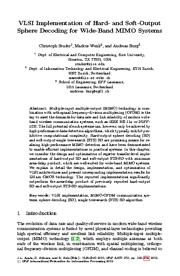VLSI Implementation of Hard- and Soft-Output Sphere Decoding for Wide-Band MIMO Systems
[chapter]
Christoph Studer, Markus Wenk, Andreas Burg
2012
IFIP Advances in Information and Communication Technology
Multiple-input multiple-output (MIMO) technology in combination with orthogonal frequency-division multiplexing (OFDM) is the key to meet the demands for data rate and link reliability of modern wideband wireless communication systems, such as IEEE 802.11n or 3GPP-LTE. The full potential of such systems can, however, only be achieved by high-performance data-detection algorithms, which typically exhibit prohibitive computational complexity. Hard-output sphere decoding (SD) and soft-output
more »
... tree-search (STS) SD are promising means for realizing high-performance MIMO detection and have been demonstrated to enable efficient implementations in practical systems. In this chapter, we consider the design and optimization of register transfer-level implementations of hard-output SD and soft-output STS-SD with minimum area-delay product, which are well-suited for wide-band MIMO systems. We explain in detail the design, implementation, and optimization of VLSI architectures and present corresponding implementation results for 130 nm CMOS technology. The reported implementations significantly outperform the area-delay product of previously reported hard-output SD and soft-output STS-SD implementations. 129 be the key for reliable, high-speed, and bandwidth-efficient data transmission. Therefore, MIMO-OFDM technology is incorporated in many modern wide-band wireless communication standards, such as IEEE 802.11n [3] or 3GPP-LTE [4]. In such systems, data detection, i.e., the separation of the multiplexed data streams, is (besides channel decoding) typically among the main implementation challenges in terms of computational complexity and power consumption. Therefore, corresponding efficient VLSI implementations are the key to enable high-performance, low-power, and low-cost user equipment. The performance of MIMO technology critically depends on the employed data-detection algorithm and corresponding high-performance methods usually entail very high complexity. In particular, a straightforward implementation of hard-output maximum-likelihood (ML) detection and soft-output a-posteriori probability (APP) detection-both providing excellent error-rate performance-requires to exhaustively test all possible transmit symbols, which results in prohibitive complexity, even for moderate data rates and in deep submicron technologies. The sphere-decoding (SD) algorithm [5-11] is known to be a promising means for efficient hard-output ML and soft-output APP detection. The key idea of SD is to transform MIMO detection into a tree-search problem, which can then be solved efficiently through a branch-and-bound procedure. The drawback of this approach lies in the fact that the decoding effort-measured in terms of the number of nodes to be examined during the tree search-depends on the instantaneous channel and noise realization. In the worst-case, the number of visited nodes, which typically corresponds to the number of clock cycles required for detection in VLSI [11, 12] , is equivalent to that of an exhaustive search [13] . Since on-chip storage and higher-layer requirements limit the processing latency that may be inferred to support the processing of received data, the worstcase complexity of SD renders its application in real-world systems extremely challenging. This challenge can be mastered by limiting the maximum decoding effort by means of early termination of the decoding process [11, 14, 15] . This approach, however, leads to a trade-off between the maximum decoding effort and the performance of the MIMO detector. Therefore, a universally applicable VLSI architecture for SD-based MIMO detection suitable for wide-band MIMO wireless communication systems must provide a robust solution allowing for the smooth adjustment of this trade-off while minimizing the required silicon area for a given minimum performance requirement. Contributions In this chapter, we describe an SD-based detector architecture for wide-band MIMO communication systems and detail corresponding design and implementation trade-offs of hard-and soft-output SD. To this end, we first review the hard-output SD algorithm and the soft-output single tree-search (STS) SD algorithm. Then, a VLSI architecture suitable for efficient data detection in wideband MIMO systems is presented and we argue that the optimization target for the parallelly-operating SD cores corresponds to minimizing the area-delay product, which differs fundamentally from minimizing the area or maximizing
doi:10.1007/978-3-642-28566-0_6
fatcat:e7arpoqrp5h75gzregw56kwe7u

